Mysterious X-37B Military Space Plane's Landing in Photos
After a record-shattering 22 months in space, the U.S. Air Force's mysterious X-37B space plane returned to Earth on Friday (Oct .17) in a smooth landing at Vandenberg Air Force Base in California. The 674-day mission launched in December 2012, but the purpose of the top secret spaceflight has been classified. The X-37B space plane landing was completely automatic and captured in images and video. You can see those amazing images here in this Space.com gallery.
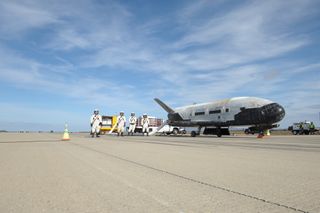
Here, the X-37B is serviced by a ground crew wearing protective suits after its successful landing on Oct. 17. The winged robotic spacecraft landed at 9:24 a.m. PDT at the Vandenberg Air Force Base to end its 22-month mission. The mission originally launched on Dec. 11, 2012. The U.S. Air Force Rapid Capabilities Office oversaw the mission, which marked the third X-37B flight since 2010. Credit: Boeing.
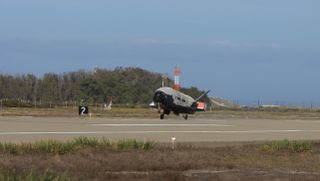
The X-37B space plane is also called the Orbital Test Vehicle (or OTV) in Air Force parlance, with its latest mission known as OTV-3. Here, the spacecraft swoops down toward the runway at Vandenberg during its pinpoint landing. [See more X-37B photos from the OTV-3 mission.]
The images here were provided to the Air Force by Boeing, which built the two X-37B space planes using its Phantom Works division. You can see some more amazing views of the landing here:
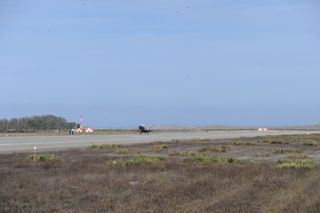
Another view of the X-37B space plane landing on Oct. 17 as it approaches the Vandenberg runway. Credit: Boeing
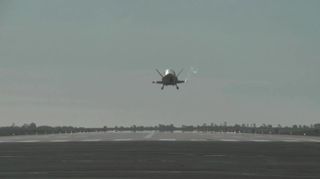
This view of the X-37B space plane landing is actually a still from an Air Force video of the landing captured on the runway at Vandenberg. The X-37B space plane that flew the OTV-3 mission was actually making its second spaceflight. The spacecraft launched on the first X-37B mission, called OTV-1. in 2010 and spent 225 days in space on that flight. This latest mission puts its time in space at 899 days. Credit: Boeing.
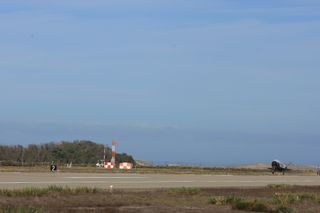
Another view of the X-37B space plane landing. While the X-37B may look like a version of NASA's space shuttles, the military space plane is actually much smaller. Two X-37B vehicles could fit inside the 60-foot payload bay of a NASA shuttle. Credit: Boeing.
Get the Space.com Newsletter
Breaking space news, the latest updates on rocket launches, skywatching events and more!
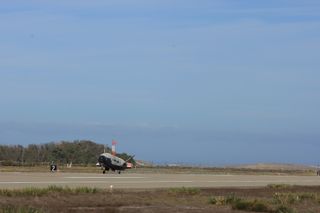
The X-37B space plane zooms by a camera during the successful landing of the OTV-3 mission at Vandenberg Air Force Base in California. A recovery team was standing ready to receive the spacecraft after its 674-day spaceflight. Credit: Boeing.
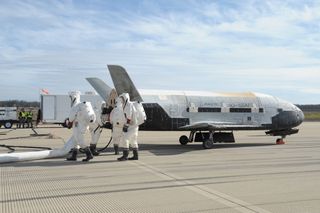
Recovery crew members work on the X-37B space plane after the vehicle's successful landing on Oct. 17. The recovery crew is responsible for processing the X-37B vehicle to make sure the vehicle is safe to be towed back to its hangar for additional work. Credit: Boeing.
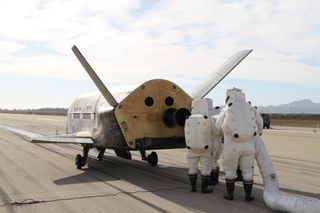
Here, the recovery crew is working on the aft of the X-37B, which houses its tail fins, rocket engine and other vital systems. The X-37B spacecraft has its own small payload (which is about the size of a pickup truck bed) and a solar array to generate power during long space missions. The black tiles and panels along its nose, wings and belly serve as a protective heat shield during re-entry. Credit: Boeing.
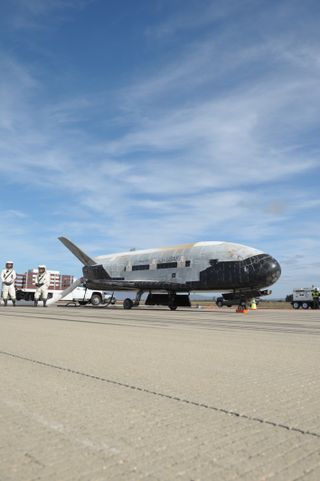
The scale of the X-37B space plane is clear in this view of the spacecraft as it is being serviced by a recovery crew. The spacecraft is about 29 feet (8.8 meters) long and 9.5 feet (2.9 m) tall. It has a wingspan of about 15 feet (4.6 m). Credit: Boeing.
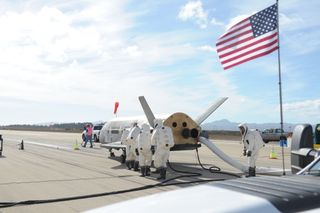
An American flag waves over the runway landing site for the U.S. Air Force's third X-37B space plane mission as recovery crew members work to process the spacecraft after its 674-day flight in this official mission photo. Credit: Boeing.
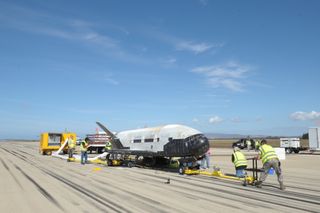
Above, the X-37B sits on the Vandenberg runway after its smooth landing on Oct. 17. Credit: Boeing.
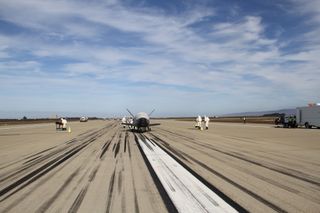
This last photo from Boeing gives us a departing look at the X-37B on the runway at Vandenberg Air Force Base. The landing on Oct. 17 marked the successful second flight of this particular X-37B vehicle, proving its viability as a reusable spacecraft. A second X-37B vehicle was used to fly the OTV-2 mission for the Air Force in 2011.
So far, all X-37B missions have launched from Cape Canaveral Air Force Station in Florida and landed at Vandenberg Air Force Base in California. The Air Force has been studying the potential of using NASA's former space shuttle landing site at the Kennedy Space Center for Florida landings of the X-37B spacecraft.
Email Tariq Malik at tmalik@space.com or follow him @tariqjmalik and Google+. Follow us @Spacedotcom, Facebook and Google+. Original article on Space.com.
Join our Space Forums to keep talking space on the latest missions, night sky and more! And if you have a news tip, correction or comment, let us know at: community@space.com.

Tariq is the Editor-in-Chief of Space.com and joined the team in 2001, first as an intern and staff writer, and later as an editor. He covers human spaceflight, exploration and space science, as well as skywatching and entertainment. He became Space.com's Managing Editor in 2009 and Editor-in-Chief in 2019. Before joining Space.com, Tariq was a staff reporter for The Los Angeles Times covering education and city beats in La Habra, Fullerton and Huntington Beach. In October 2022, Tariq received the Harry Kolcum Award for excellence in space reporting from the National Space Club Florida Committee. He is also an Eagle Scout (yes, he has the Space Exploration merit badge) and went to Space Camp four times as a kid and a fifth time as an adult. He has journalism degrees from the University of Southern California and New York University. You can find Tariq at Space.com and as the co-host to the This Week In Space podcast with space historian Rod Pyle on the TWiT network. To see his latest project, you can follow Tariq on Twitter @tariqjmalik.









